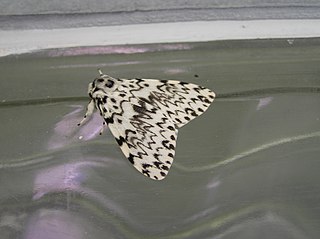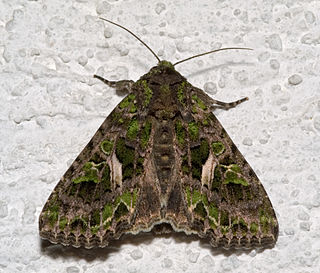
Acronicta is a genus of noctuid moths containing about 150 species distributed mainly in the temperate Holarctic, with some in adjacent subtropical regions. Caterpillars of most Acronicta species are unmistakable, with brightly colored hairy spikes, and often feed quite visibly on common foliate trees. The larva of the smeared dagger moth is unusually hairy even for this genus. Acronicta species are generally known as dagger moths, as most have one or more black dagger-shaped markings on their forewing uppersides. But some species have a conspicuous dark ring marking instead.

Orgyia is a genus of tussock moths of the family Erebidae. The genus was described by Ochsenheimer in 1810. The species are cosmopolitan, except for the Neotropical realm.

Lymantria is a genus of tussock moths in the family Erebidae. They are widely distributed throughout Europe, Japan, India, Sri Lanka, Myanmar, Java, and Celebes. The genus was described by Jacob Hübner in 1819.

Trachea is a genus of moths of the family Noctuidae erected by Ferdinand Ochsenheimer in 1816.

Gastropacha is a genus of moths in the family Lasiocampidae. It was first described by Ochsenheimer in 1810.

Notodonta torva, the large dark prominent, is a moth of the family Notodontidae. The species was first described by Jacob Hübner in 1803. It is found in most of Europe, east to the China, Korea and Japan.

Aglia is a genus of moths in the family Saturniidae first described by Ochsenheimer in 1810. It is the only genus in the subfamily Agliinae.







